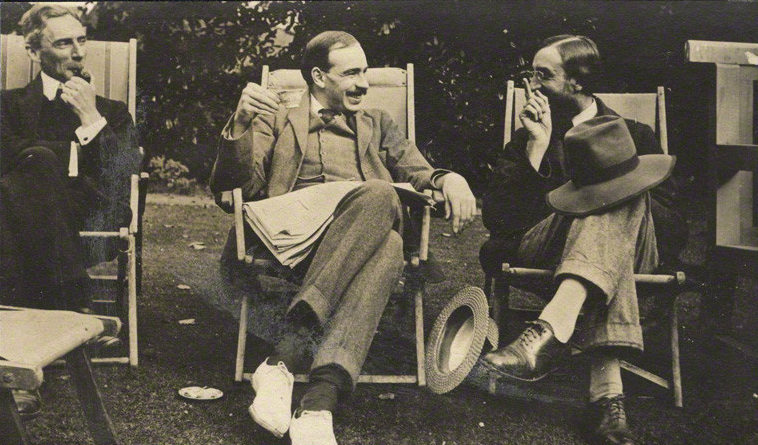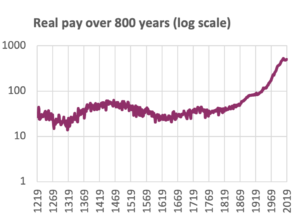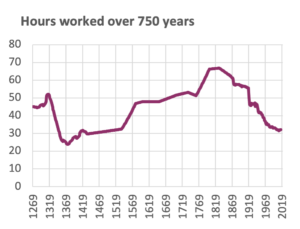
On the economic front, this period saw the theories of John Maynard Keynes provide the sound intellectual framework for the views which trade unionists had always instinctively known to be right.
Trades Union Congress, The History of the T.U.C. 1868-1968, p. 85
The bond between Keynes and workers – obvious to trades unionists in 1968 – is obscured in the latest commentary on working hours by Keynes’s own biographer, Lord Skidelsky.
As the pandemic eases, Lord Skidelsky on 17 February warned Daily Mail readers that it was “deluded to think that working from home and a four-day week is anything other than a looming disaster for the UK.” Twice he appeared to condemn “Labour leaders [that] have long advocated a world where their members work fewer hours for more money”.
Er, yes. And – up to a point – workers have been incredibly successful.

The available data (shown on the charts here) suggest that real wages advanced decisively from around the beginning of the nineteenth century. And, likewise, hours have fallen continuously from roughly the same point. Henry Pelling, the author of A History of British Trade Unionism (1963, p. 24), reckons this is the point at which trade unions became a force to be reckoned with: “The extent and efficacy of combinations in the later eighteenth century” he observes, “provoked the active hostility of parliament”. By 1833 the ‘Factory Acts’ began gradually to restrict working hours. Even Karl Marx, no great believer in the reforming virtues of the bourgeois state,[1] celebrated the “legally limited working day, which at lasts makes clear ‘when the time which the worker sells is ended, and when his own begins’. Quantum mutatus ab illo [What a great change from that time, from Virgil’s Aeneid]” (Marx, 1976, p. 416).

But Lord Skidelsky only judges trends in hours against Keynes’s prediction that ‘our grandchildren’ might enjoy working only a 15-hour week. He thus sidesteps the still profound achievements that have so far been made. Moreover, his reasoning here is important. Keynes may have anticipated increasing automation (so permitting more efficient production), but Skidelsky argues he failed to anticipate the insatiable demand for goods and services on the part of workers (meaning more production necessary overall). With the latter meaning upward pressure on hours, Keynes’s idea of a 15-hour week was, sadly, wrong.
However, it doesn’t therefore follow that those who advocate reduced hours today, have, in Lord Skidelsky’s words, a “dismal understanding of economics”. Apparently ignorant of the insatiable appetite of their members for more work and more consumption, union leaders are alleged to reason simplistically as follows:
The demands of trade union leaders for a four-day week are still rooted in the idea of work-sharing. In their eyes, the labour force should be spread as widely as possible to ensure there is no unemployment. Each worker ‘needs’ a job, so by cutting the number of working hours, the number of jobs increases.
In effect Lord Skidelsky is arguing that trade unions adhere to the lump of labour/wage fund fallacy, which can be traced back to at least Ricardo in 1815. Nor is he the first to do so: Sidney and Beatrice Webb claimed likewise from their ivory tower at the London School of Economics. This is the belief that the quantity of work and wages represent nothing more than the total capital of society divided by the population, and takes no account of the complex dynamism of capital itself.
As the economic historian R.V. Clemens pointed out as long ago as 1961, the accusation is unfair to trade uinon leaders: “[a]s for the wage fund theory, union leaders never accepted it in any significant sense, since it was shattered by practically everything they did”.
Ironically Lord Skidelsky’s argument simply modifies the lump/fund fallacies, with technology and taste allowed to change the size of the lump/fund over time. If the workers want ‘indoor toilets’ or more than ‘two sets of clothes’, Lord Skidelsky asserts they will have to work more, not less, because there is only so much capital to go around.
Keynes’ alternative
Keynes’s approach was very different. In the General Theory he took these factors as ‘given’ and not relevant to the argument he was making (“we take as given the existing skill and quantity of available labour, the existing quality and quantity of the available equipment … the tastes and habits of the consumer …”, p. 245). He showed that increasing aggregate demand would lead to a permanently stronger economy. His primary focus was releasing previously contained (and disrupted) aggregate demand through a lower long-term rate of interest, a point I was at pains to make in Keynes Betrayed.
In contrast, the so-called ‘Keynesian’ economists who took his work forwards after the Second World War, have tended instead to focus exclusively on the role of government expenditure. The labour movement (and many ‘post-Keynesian’ economists today, e.g. Stockhammer and Lavoie, 2013) have given more emphasis to the role of higher pay in stimulating aggregate demand. ‘Wage-led growth’ is a critical priority for the Trades Unions Advisory Committee to the OECD – see the report ‘Framing the Recovery: Pathways for a World in Transition’ submitted and presented to the OECD liaison Committee in February 2022. Today ‘wage-led growth’ is a critical priority for the Trades Unions Advisory Committee to the OECD.[2]
Trade union leaders have, since the movement began, understood the basic macroeconomic truth that higher pay will not only be better for workers but better for the economy. And as we have always argued – for example most recently in A future that works for working people – reduced hours are then an additional way to share that increased prosperity. As the charts show, so it has proved in practice.
It is all too easy to revert to the orthodoxy of the industrial revolution, that somehow technology alone set us on the trajectory to today’s prosperity. And even ‘Keynesian’ economists impose the same underlying scenario on their gravely diminished Keynes.
But Keynes’s theory and the view from the labour movement tells us that causality is the other way around. Advanced technology hasn’t created more prosperity, more prosperity has advanced technology!
Slowly improving labour conditions and some rebalancing away from wealth meant a greatly advantaged economy, and set in motion a virtuous cycle of higher pay, more consumption, increased activity, improved technology and lower hours. The consumption was not insatiable, it just reflected what an economy operating less badly could deliver. Workers do not demand unending and unlimited consumption, they demand what they have always demanded – their fair share of what they themselves produce.
Keynes’ idealism against the struggle for power
Keynes’s 15-hour prediction is of greater interest from the point of view of his failure to influence policy. As his more streetwise colleague Joan Robinson put it:
The great trouble with Keynes was that he was an idealist. He thought that when people could understand his theory, could understand how the capitalistic system actually works, they would behave in a reasonable manner and operate the system in such a way as to produce favourable results, to produce in particular a high and stable level of employment.
Kahn, 1984, pp. 203-4
For some decades after the Second World War policy was closest to – but still a good distance from –Keynes’s and Labour’s ideal; from the 1980s, as we all know, Thatcher and Reagan led the charge in reversing Labour’s advance. This, as we also know, was not a question of rational economics, but a struggle for power between competing interests.
Incidentally, if we project hours to 2021 at the pace of improvement over 1945 to 1975 then by 2021 a 20-hour week would now be the norm.
Lord Skidelsky not only does not discuss the long-term trend, but also neglects to mention what happened in the most recent decade. In a unique and disastrous departure from a two-century old trajectory, both real pay declined and hours rose. The likely explanation is that people have had to work more hours because pay has for the first decade gone into reverse. Skidelsky’s argument does not account for this change.
We should regard this reversal as indicative of the end point of the decisive restoration of the dominance of wealth over labour and, with it, the diminishing influence of any sane economics. Further: any perceptions around the impact of the pandemic must be tempered by the understanding that COVID19 ensured that wealth enjoyed even greater gains.
Three cheers to those who have secured reductions in the working week for unchanged pay. However it remains unlikely that the majority of the workers in an economy with 14 million children in poverty will be able to duck out of the labour force very easily – let alone enjoy the comfort of an en-suite bathroom. The existence of zero hours’ contracts simply tells us how far down the road to casualisation we have travelled and the sooner they are banned the better. Workers on these exploitative contracts do not ‘want to work more’ as Skidelsky claims, they want to be paid properly and to enjoy the security their parents’ generation took for granted.
We have been grateful for Lord Skidelsky’s dogged campaigning against austerity policies for the past 13 years. But, as trade union leaders of the past understood, the common ground between Keynes and the Labour movement goes much deeper. The need is to begin again to construct an economy that puts workers in front place, while constraining wealth. Keynes does not lambast workers for wanting to escape the present, profoundly dysfunctional economy, he is on their side.
References
Clements, R. V. (1961) British Trade unions and popular political economy 1850 – 1875. Economic History Review.
Kahn, Richard E. (1984) The Making of The General Theory, Cambridge University Press.
Lavoie, Marc and Engelbert Stockhammer (2013) Wage-led Growth: An Equitable Strategy for Economic Recovery, Palgrave Macmillan and the International Labour Office.
Marx, Karl (1976) Capital: A Critique of Political Economy, Volume One, Penguin Books in association with New Left Review.
Pelling, Henry (1963) A History of British Trade Unionism, Penguin Books Ltd.: Harmondsworth
Ricardo, David (1817) On the Principles of Political Economy and Taxation.
Tily, Geoff (2010 [2006]) Keynes Betrayed, Basingstoke: Palgrave Macmillan.
Trades Unions Advisory Committee (2022) ‘Framing the Recovery: Pathways for a World in Transition’, submitted and presented to the OECD Liaison Committee with Non-Governmental Organisations, 21 February 2022: https://tuac.org/news/oecd-tuac-liaison-committee-meeting-policies-for-framing-the-recovery-en-fr/
TUC (1968) The History of the T.U.C. 1868-1968 A Pictorial Survey of a Social Revolution
TUC (2018) A future that works for working people: https://www.tuc.org.uk/research-analysis/reports/future-works-working-people
[1] Many thanks to my colleague Rob Maisey for helping further to bridge between Keynes and left.
[2] See the report ‘Framing the Recovery: Pathways for a World in Transition’ submitted and presented to the OECD liaison Committee in February 2022








